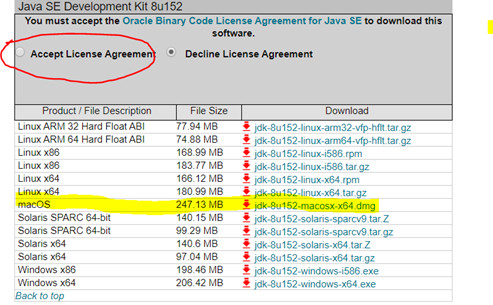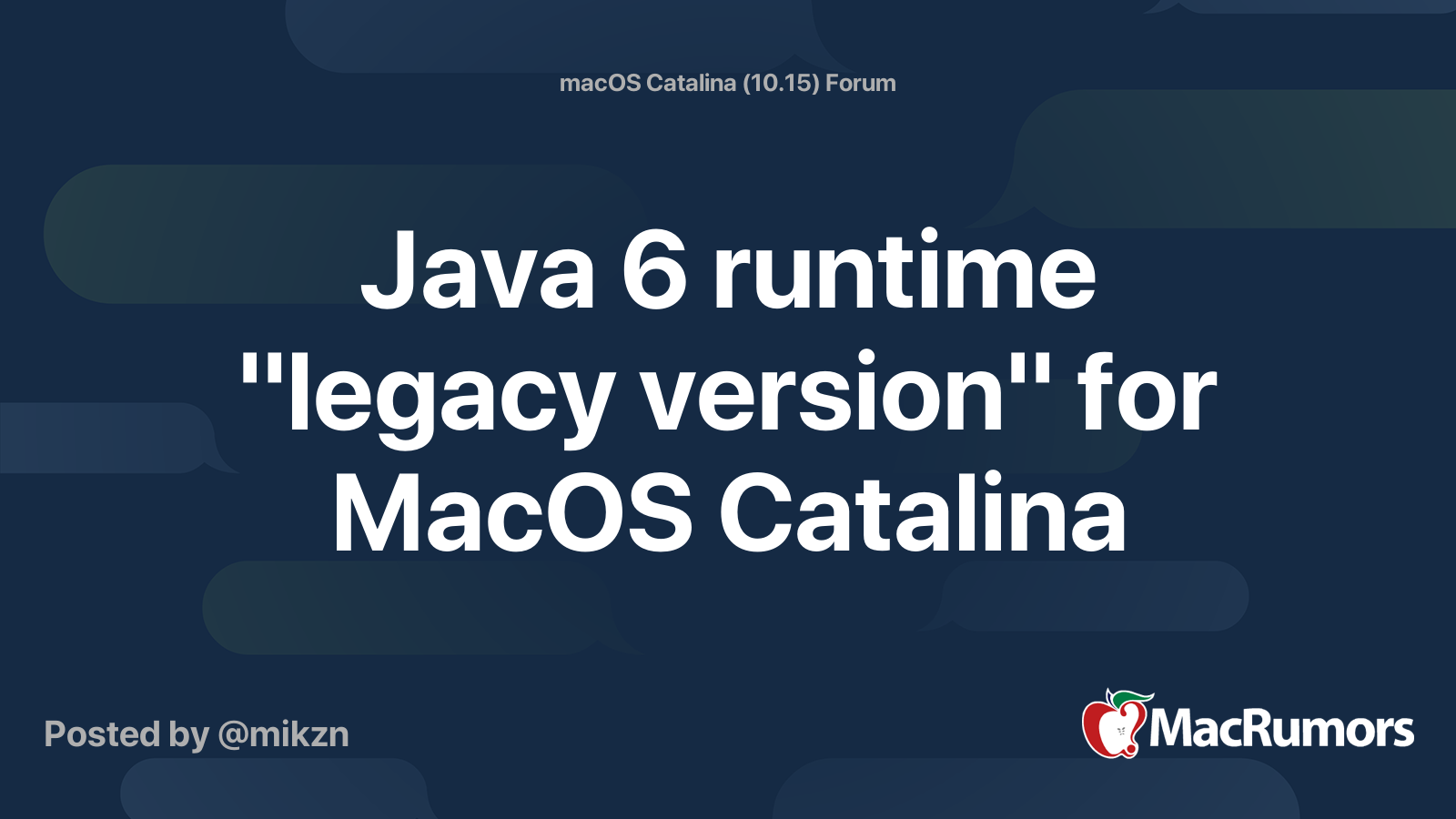Installing the JDK on macOS. When you install the JDK, the associated JRE is installed at the same time. The JavaFX SDK and Runtime are also installed and integrated into the standard JDK directory structure. To install the JDK on macOS: Download the JDK.dmg file, jdk-10.interim.update.patch-macosx-x64.dmg. Mac OS X Version 10.6 and below. Use Software Update available on the Apple menu to check that you have the most up-to-date version of Java 6 for your Mac. Java 7 and later versions are not supported by these older versions of Mac OS X. If you have problems with Java 6, contact Apple Technical Support.
JDK 9 & Later
Oracle's OpenJDK JDK binaries for Windows, macOS, and Linux areavailable on release-specific pages of jdk.java.net as .tar.gz or.zip archives.
As an example, the archives for JDK 13 may be found on jdk.java.net/13 and may be extractedon the command line using
$ tar xvfopenjdk-13*_bin.tar.gz
or
$ unzipopenjdk-13*_bin.zip
depending on the archive type.
JDK 8
Debian, Ubuntu,etc.
On the command line, type:
$ sudo apt-get installopenjdk-8-jre
The openjdk-8-jre package containsjust the Java Runtime Environment. If you want to develop Javaprograms then please install the openjdk-8-jdk package.
Fedora, OracleLinux, Red Hat Enterprise Linux, etc.
On the command line, type:
$ su -c 'yum installjava-1.8.0-openjdk'
The java-1.8.0-openjdk packagecontains just the Java Runtime Environment. If you want to developJava programs then install the java-1.8.0-openjdk-devel package.
JDK 7
Debian, Ubuntu,etc.

On the command line, type:
$ sudo apt-get installopenjdk-7-jre
The openjdk-7-jre package containsjust the Java Runtime Environment. If you want to develop Javaprograms then install the openjdk-7-jdkpackage.
Fedora, OracleLinux, Red Hat Enterprise Linux, etc.
On the command line, type:
$ su -c 'yum installjava-1.7.0-openjdk'
The java-1.7.0-openjdk packagecontains just the Java Runtime Environment. If you want to developJava programs then install the java-1.7.0-openjdk-devel package.
JDK 6
Debian, Ubuntu,etc.
On the command line, type:
$ sudo apt-get installopenjdk-6-jre
The openjdk-6-jre package containsjust the Java Runtime Environment. If you want to develop Javaprograms then install the openjdk-6-jdkpackage.
Fedora, OracleLinux, Red Hat Enterprise Linux, etc.
On the command line, type:
$ su -c 'yum installjava-1.6.0-openjdk'

The java-1.6.0-openjdk packagecontains just the Java Runtime Environment. If you want to developJava programs then install the java-1.6.0-openjdk-devel package.
BSD Port
For a list of pointers to packages of the BSD Port forDragonFly BSD, FreeBSD, Mac OS X, NetBSD and OpenBSD, please seethe BSD porting Project's wikipage.
This page tells you how to download and install Java 8 and Eclipse on Mac OS X, and how to configure Eclipse.
Mac Os X 10.11 Download
How to Download and Install Java JDK on Mac OS X Do you want to know how to install the Java JDK 11 (Java SE Development Kit) on your Mac? Well, you're in th. You can download the Mac OS X JDK and JRE from Java SE Downloads page. A new Install App is available for easy installation of the JDK and the JRE. For information on installing JDK and JRE 7u6 for Mac OS X, see Installation for Mac OS X page. Java SE 6 Downloads. Go to the Oracle Java Archive page. Thank you for downloading this release of the Java TM Platform, Standard Edition Development Kit (JDK TM).The JDK is a development environment for building applications, applets, and components using the Java programming language. Lg flatron e2350v driver for mac.Running the Java Preferences utilily shows that the most recent version of Java installed on my Mac Pro in Snow Leopard (10.6.8) is Java SE6 v1.6.051-b11-456 (both 32-bit and 64-bit versions are available), which was installed with Update 16.
Jdk 6 Download Mac Os X Download

Installing Java 8
Go to the Oracle website. You'll see something like this:
Scroll down until you see a heading beginning 'Java SE 8u65/8u66.' On the right, you'll see a Download button under the JDK header. Click it. The next screen will look like this:
Click the radio button next to 'Accept License Agreement' and then click on jdk-8u65-macosx-x64.dmg. You'll be asked whether to save the file that is going to be downloaded; click on Save File.
Open your Downloads folder, and double-click on jdk-8u65-macosx-x64.dmg. You'll see this window:
Double-click on the package icon, and follow the instructions to install. When the installation has completed, click on Done. At this point, you may close up the window and drag jdk-8u65-macosx-x64.dmg to the Trash.
Installing Eclipse
If you already have Eclipse installed on your Mac, you need to get rid of it. To do so, first quit Eclipse if you're currently running it. Then, go to your workspace folder (probably in Documents/workspace) and save anything there that you want to keep, because you're about to get rid of this folder. Next, drag the workspace folder to the Trash.
Go to your Applications folder. One way to get there is, from the Finder, type command-shift-A. You'll a folder named eclipse in there; drag the eclipse folder to the Trash. If you have an Eclipse icon in your dock, remove it from the dock.
Now you're ready to download and install the newest version of Eclipse. Go to this website. You'll see a window like this:
Scroll down until you see 'Eclipse IDE for Java Developers' and click where it says 64 bit under Mac OS X.
You will see this window:
Click on the yellow download button. If asked, click on 'Open with Archive Utility (default)' and then click OK. The download might take a few minutes. You should not feel compelled to donate.
After the download completes, folders should automatically expand. If they don't, double-click on the .tar file. When that's done, you should see a folder named eclipse in your Downloads folder. When you open your Downloads folder, if you see Applications under the Favorites on the left side of the window, you should drag the eclipse folder into Applications. If you don't see Applications, then open a new window for Applications (from the Finder, command-shift-A), and drag the eclipse folder into Applications.
Open your Applications folder, and then open the eclipse folder. You'll see an item named Eclipse; if you like, drag its icon into the dock so that you'll be able to launch Eclipse easily.
Launch Eclipse. If you're asked whether you want to open it, of course you do; click Open. You'll see a window like this:
It will have your user name rather than mine (scot). Select where you want your workspace to be; I recommend the default of your Documents folder. Click the checkbox for using this location as the default, and then click OK.
You'll see a window like this:
Click on the Workbench arrow in the upper right that I've circled. You shouldn't see this screen again, even if you quit Eclipse and relaunch it.
You'll get an empty workbench like this:
We won't be using the 'Task List' and 'Connect Mylyn' windows. Click the 'x' on each to close it. Press the mouse on the Window menu item, then choose 'Perspective', and finally choose 'Save Perspective as..'. Enter 'cs10' for the name of this perspective and press return. Your workbench will now look like this:
You have now installed Eclipse!
Configuring Eclipse
You don't have to configure Eclipse the way I do, but you'll probably avoid some confusion if you do. Here's how.
Java Jdk 6 Download Mac Os X64
Jdk 1.5 Download 64 Bit

Download Jdk For Mac
In the Eclipse menu bar, click on the Eclipse menu and then on 'Preferences..'. You'll see a window with two panes. On the left pane is a list of types of things you can configure.
Click on the triangle to the left of General. Then click on the triangle to the left of Appearance. Then click on 'Colors and Fonts.' You should see a window like this:
In the window in the middle, click on the triangle next to Java. Then double-click on 'Java Editor Text Font':
You'll see this window:
On the right, where you can select the size, click 12. Then close this window by clicking on the window's close button.
Close up the General preferences by clicking on the triangle to the left of General. Click the triangle next to Java and then click the triangle next to 'Code Style.' Then click Formatter. Here's what you should see:
Click the button that says 'New..'. You'll see a window such as this one:
You can type in any profile name you like. I used 'CS 10':
Click OK.
You should see a window like this:
Change the tab size to 2:
You'll see that the indentation size automatically changes as well.
Click on 'Blank Lines,' and after 'Between import groups' and 'Before declarations of the same kind,' change the values 1 to 0:
Click on 'Control Statements,' and check the first four boxes as I've done here:
Click OK.
Now click on triangles to close up Java. Click on the triangle next to Run/Debug, and then click on Console:
Click on the green color sample next to 'Standard In text color.' You'll get a color picker:
Slide the slider on the right down, so that you get a dark green. (You're at Dartmouth. What other color could you possibly want?)
Close the color picker window by clicking its close button, and click OK again to close the Preferences window.
And you're done!